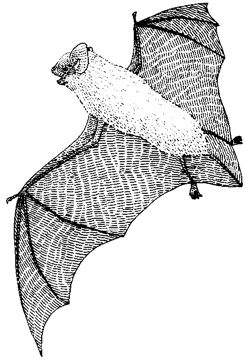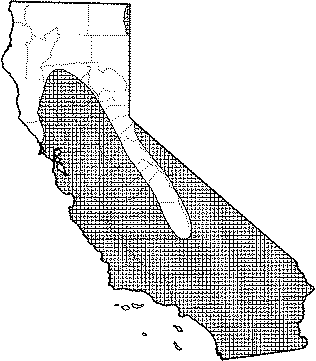
Western Pipistrelle
Distribution, Abundance, and Seasonality
The western pipistrelle is a common to abundant resident of deserts and arid grasslands and woodlands. In California, this species occurs in the Central Valley, foothills, and Coast Ranges from Tehama Co. to Mexico, and in the deserts from Alpine Co. to Mexico. Extreme eastern Modoc Co. is also inhabited. Occupies all desert, brush, grassland, and woodland habitats up through mixed conifer forests. The most abundant bat in desert regions. Common in arid brushlands, grasslands, and woodlands, and uncommon in conifer forests. This species is a yearlong resident in California.

Range Map
Specific Habitat Requirements
Feeding: Feeds on a wide variety of flying insects, including moths, Diptera, Homoptera, Hymenoptera, Hemiptera, and Coleoptera. The primary food varies between studies (Ross 1967, Black 1974, Whitaker et al. 1981), but soft-bodied prey are the major foods. Flight is slow and fluttery. Feeds at low to moderate heights. Often found foraging over water, in rocky canyons, and along cliff faces.
Cover: Roosts primarily in rock crevices, occasionally in mines and caves, and rarely in buildings. Suitable roosts are most often found in rocky canyons and cliffs.
Reproduction: Born and reared singly, or in small maternity colonies in rock crevices.
Water: Produces a very concentrated urine, and maintains positive water balance for 1.5 wk without water (Geluso 1978). Lactating females may require frequent water. They comprise a large proportion of individuals taken over water sources. All individuals probably require occasional water.
Pattern: Prefers rocky canyon walls and cliffs in arid habitats.
Species Life History
Activity Patterns: Nocturnal, reduced activity in winter. This species emerges earlier than other bats. It may be seen as early as 45 min before sunset, and often is seen after sunrise. Most activity is in the first 1-2 hr after sunset. Reported temperatures during activity range from -5ÁC to 33ÁC (23-92ÁF). Optimum temperature for activity is 16Á C to 30Á C (61 -86Á F). Strong winds inhibit activity. Active at any time of year, but peak activity occurs in the summer months. Peak activity in winter coincides with higher temperatures. Individuals active in winter are mostly males. This species uses hypothermia to conserve energy during periods of cold temperature (Cockrum and Cross 1964, Cox 1965, Jones 1965, O'Farrell et al. 1967, Bradley and O'Farrell 1969, O'Farrell and Bradley 1970).
Seasonal Movements / Migration: Yearlong resident in California. May make local movements, but no data found on movements.
Home Range: No data found.
Territory: No data found .
Reproduction: Pregnant females are found in May and June. Births are in June and July, with a peak in mid-June. The single yearly litter has 1 or 2 young. Lactating females are found in June and July. Most young are capable of flight in July.
Niche: This small, maneuverable bat takes small, mostly soft-bodied insects at medium to low heights. Found foraging with a number of bat species, and has been seen foraging among violet-green swallows. Possible predators include owls and large bats.
Comments: Like many bats, this species is sensitive to disturbance of roost sites.
Sources & References
California Department of Fish and Game, 1999.
California's Wildlife, Sacramento, CA.
Written by: J. Harris, reviewed by: P. Brown, edited by: D. Alley, R. Duke
Barbour, R. W., and W. H. Davis. 1969. Bats of America. Univ. of Kentucky Press, Lexington. 286pp. Black, H. L. 1974. A north temperate bat community: structure and prey populations. J. Mammal. 55:138-157. Bradley, W. G., and M. J. O'Farrell. 1969. Temperature relationships of the western pipistrelle (Pipistrellus hesperus). Pages 85-96 in C. C. Hoff, and M. L. Riedesel, eds. Physiological systems in semiarid environments. Univ. New Mexico Press, Albuquerque. Cockrum. E. L., and S. P. Cross. 1964. Time of bat activity over waterholes. J. Mammal. 45:635-636. Cox, T. J. 1965. Seasonal changes in the behavior of the western pipistrelle because of lactation. J. Mammal. 46:703. Cross, S. P. 1965. Roosting habits of Pipistrellus hesperus. J. Mammal. 46:270-279. Findley, J. S., and G. L. Traut. 1970. Geographic variation in Pipistrellus hesperus. J. Mammal. 51:741-765. Geluso, K. N. 1978. Urine concentrating ability and renal structure of insectivorous bats. J. Mammal. 59:312-323. Hatfield, D. M. 1936. A revision of the Pipistrellus hesperus group of bats. J. Mammal. 17:257-262. Hayward, B. J., and S. P. Cross. 1979. The natural history of Pipistrellus hesperus (Chiroptera: Vespertilionidae). West. New. Mex. Univ., Res. Sci. 3:1-36. Jones, C. 1965. Ecological distribution and activity records of bats of the Mogollon Mountains area of New Mexico and adjacent Arizona. Tulane Studies Zool. 12:93-100. Koford, C. B., and M. R. Koford. 1948. Breeding colonies of bats, Pipistrellus hesperus and Myotis subulatus melanorhinus. J. Mammal. 29:417-418. Miller, A. H., and R. C. Stebbins. 1964. The lives of desert animals in Joshua Tree National Monument. Univ. California Press, Berkeley. 452pp. Moor, K., F. Stay, and W. G. Bradley. 1965. Mexican free-tailed bat and western pipistrelle found roosting in sedges. J. Mammal. 46:507. O'Farrell, M. J., and W. G. Bradley. 1970. Activity patterns of bats over a desert spring. J. Mammal. 51:18-26. O'Farrell, M. J., W. G. Bradley, and G. W. Jones. 1967. Fall and winter bat activity at a desert spring in southern Nevada. Southwest. Nat. 12:163-171. Ross, A. 1967. Ecological aspects of the food habits of insectivorous bats. Proc. West. Found. Vertebr. Zool. 1:205-264. Stager, K. E. 1943. Notes on the roosting place of Pipistrellus hesperus. J. Mammal. 24:266-267. Von Bloeker, J. C., Jr. 1932. The roosting place of Pipistrellus hesperus. J. Mammal. 13:273. Whitaker, J. O., Jr., C. Maser, and S. P. Cross. 1981. Food habits of eastern Oregon bats, based on stomach and scat analyses. Northwest Sci. 55:281-292.
California Animal Facts | California's Wildlife